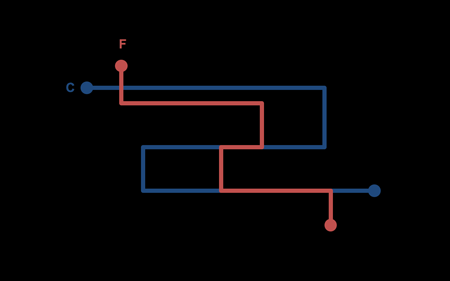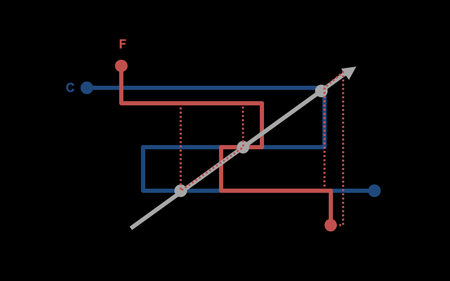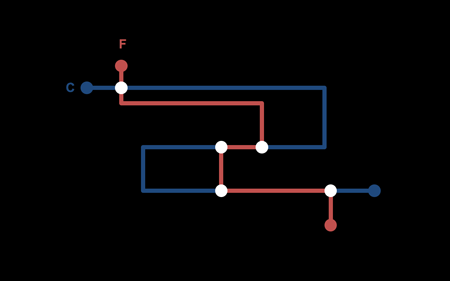Today ended a two-day blitz of work that took the form of an Accenture case competition. The event was sponsored by the Kelley School of Business as an extension of one of their business classes, taught by Paul Friga. This year, the competition was opened up a bit, and IU School of Informatics Director of Undergraduate Studies Dennis Groth recruited five Informatics teams to participate.
There were five people to a team, each participant given a twelve-hour limit on how much work was allowed. The clock started on Wednesday night and ended about 35 hours later with a power point file submission to Friga Friday morning. Besides the thrill of competition and the experience of a business case, participants had a shot at a share of $6000 offered by Accenture as prize money. Finishing first in the two-round competition earned each individual on the winning team $750. Judges were a combination of professionals from Accenture and IU faculty.
The most positive comment was on one particular slide we engineered in our presentation. The slide was animated, so it is broken up below into a few screen shots.

Fans and Teams have their own routines

Traditional technology doesn’t account for existing routines

Find the natural overlaps of routine
This was the key insight of our proposal, and we gave it a prominent position in our presentation to emphasize our approach toward the problem, which dealt with how to identify the people who actually attend baseball games for a club needing to improve season ticket sales.
Fans have a routine. The company has a routine, too. In the absence of the other, they each will go through their days on a track optimized to meet their needs. Typically, however, any technology thrown at a problem relevant to both produces systems built in a way that benefits the IT in the company. This forces fans to go out of their routine to interface with the system in ways dictated by the programmers. Instead, we want to look for the places where the routines of both the fans and the company interact, naturally, and situate our tech solutions there. These interfacing points are both cost efficient and more enjoyable for those involved, stimulating interaction throug a lower barrier of entry.
The killer slide had our judges on the edge of their seats, ready to accept what we had to say next … until they realized we weren’t going to ever talk in numbers.
Informatics means business-deficient
No Informatics team made the cut to the final six of the thirty entries. That wasn’t really a surprise, once the nature of the competition was revealed Wednesday. In addition to forcing a 15-slide limit (in 25 minutes, with sniper questioning interrupting the flow), the rules specifically outlawed consultation. In other words, the people trained in understanding the user’s perspective weren’t allowed to interview any users. Or administrators. Or any stakeholders in the problem needing a solution. While the 12-hour individual clock and less than two day turnaround naturally constrained our ability to do that kind of inquiry, it wouldn’t have been a stretch to network to find professional contacts to provide some insights and user test a few ideas.
The business case also required a set of skills we aren’t really taught at SOI—financial analysis. Although the feedback we received indicated that we could have been very successful and competitive with even a single slide with some fictional (but reasonable) numbers projecting a benefit, the intimidation factor and lack of understanding about the fuzziness of business analysis prevented that from happening. All five of us thought the numbers we showed needed to originate from some source, like a secret library of financial databases that only business folk would know about. More to the point, we assumed that the business students would be so far ahead of us in their financial analysis that it made sense to downplay it in our pitch. Apparently, a Herald-Times write-up of how the Five Buck Club is improving Keresotes attendance in Bloomington would have been enough to fill out a simple spreadsheet and get us into the finals.
The SOI program doesn’t need much to correct this, but it does need to do something. In the context of training human-computer interaction designers the PRInCiPleS framework—an attempt by Eli Blevis and others to give the process a logical, scientific approach to a design argument—the program is excellent at providing the means to get to high-level concepts. Those who enter with programming and visual skills also do well in getting to the prototyping level of a design project. However, it is rare and certainly not due to the School when a student exits with real-world skills in strategic planning from a business perspective. The capstone class, which consumes 1/3 of the second year of the masters degree, is a missed opportunity to provide this training. Another way might be to create a business elective that allows us to work on the business cases for our project work.
The case competition experience was a positive one in a couple regards. First, I got to work with some people I hadn’t before, including a bioinformatics doctoral student and some undergrads. It definitely made the very long day-and-a-half time well spent. Second, I got a major dose of confidence in my ability to walk in the real world. We didn’t win, but the path to winning something similar in the future is clearer now. Just knowing the emphasis is on the plausibility of projections and not the validity of the figures is a big relief.